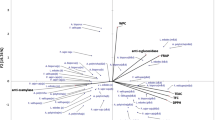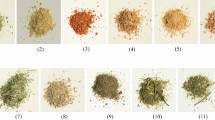Abstract
Nutritional value of cooked food has been considered to be lower compared to the fresh produce. However, many reports showed that processed fruits and vegetables including mushrooms may retain antioxidant activity. Pleurotus spp. as one of the edible mushroom are in great demand globally and become one of the most popular mushrooms grown worldwide with 25-fold increase in production from 1960–2009. The effects of three different cooking methods (boiling, microwave and pressure cooking) on the antioxidant activities of six different types of oyster mushrooms (Pleurotus eryngii, P citrinopileatus, P. cystidiosus P. flabellatus, P. floridanus and P. pulmonarius) were assessed. Free radical scavenging (DPPH) and reducing power (TEAC) were used to evaluate the antioxidant activities and the total phenolic contents were determined by Folin-Ciocalteu reagent. Pressure cooking improved the scavenging abilities of P. floridanus (>200 %), P. flabellatus (117.6 %), and P. pulmonarius (49.1 %) compared to the uncooked samples. On the other hand, the microwaved Pleurotus eryngii showed 17 % higher in the TEAC value when compared to the uncooked sample. There was, however, no correlation between total phenolic content and antioxidant activities. There could be presence of other bioactive components in the processed mushrooms that may have contributed to the antioxidant activity. These results suggested that customized cooking method can be used to enhance the nutritional value of mushrooms and promote good health.
Similar content being viewed by others
References
Amin I, Lee WY (2005) Effect of different blanching times on antioxidant properties in selected cruciferous vegetables. J Sci Food Agric 85:2314–2320
Borowski J, Szajdek A, Borowska EJ (2008) Content of selected bioactive components and antioxidant properties of broccoli (Brassica oleracea L.). Eur Food Res Technol 246:459–465
Chang ST, Wasser SP (2012) The role of culinary-medicinal mushrooms on human welfare with a pyramid model for human health. Int J Med Mushrooms 14:95–134
Choi Y, Lee SM, Chun J, Lee HB, Lee J (2006) Influence of heat treatment on the antioxidant activities and polyphenolic compounds of Shiitake (Lentinus edodes) mushroom. Food Chem 99:381–387
Dewanto V, Wu XZ, Adom KK, Liu RH (2002a) Thermal processing enhances the nutritional value of tomatoes by increasing total antioxidant activity. J Agric Food Chem 50:3010–3014
Dewanto V, Wu X, Liu RH (2002b) Processed sweet corn has higher antioxidant activity. J Agric Food Chem 50:4959–4964
Elmastas M, Isildak O, Turkekul I, Temur N (2007) Determination of antioxidant activity and antioxidant compounds in wild edible mushrooms. J Food Comp Anal 20:337–345
Ferreira IC, Barros L, Abreu RM (2009) Antioxidants in wild mushrooms. Curr Med Chem 16:1543–60
Galor SW, Wong KW, Benzie IFF (2008) The effect of cooking on Brassica vegetables. Food Chem 110:706–710
Gerhauser C, Klimo K, Heiss E, Neumann I, Gamal-Eldeen A, Knaulft J, Liu GY, Sitthimonchai S, Frank N (2003) Mechanism- based in vitro screening of potential cancer chemopreventive agents. Mutat Res: Fund Mol Mech Mutagen 523–524:163–172
Gogavekar SS, Rokade SA, Ranveer RC, Ghosh JS, Kalyani DC, Sahoo AK (2012) Important nutritional constituents, flavour components, antioxidant and antibacterial properties of Pleurotus sajor-caju. J Food Sci Tech. doi:10.1007/s13197-012-0656-5
Hayat K, Hussain S, Abbas S, Farooq U, Ding B, Xia S, Jia C, Zhang X, Xia W (2009) Optimized microwave-assisted extraction of phenolic acids from citrus mandarin peels and evaluation of antioxidant activity in vitro. Sep Purif Technol 70:63–67
Huang DJ, Ou BX, Prior RL (2005) The chemistry behind antioxidant capacity assays. J Agric Food Chem 53:1841–1856
Jagadish LK, Krishnan VV, Shenbhagaraman R, Kaviyarasan V (2009) Comparative study on the antioxidant, anticancer and antimicrobial property of Agaricus bisporus (J. E. Lange) imbach before and after boiling. Afr J Biotechnol 8(4):54–661
Jayakumar T, Thomas PA, Geraldine P (2009) In-vitro antioxidant activities of an ethanolic extract of oyster mushroom, Pleurotus ostreatus. Innov Food Sci Emerg Technol 10:228–234
Jiménez-Monreal AM, Garcia-Diz L, Martinex-Tome M, Mariscal M, Murcia MA (2009) Influence of cooking methods on antioxidant activity of vegetables. J Food Sci 74(3):H97–H103
Kanagasabapathy G, Malek SRA, Kuppusamy UR, Vikineswary S (2011) Chemical composition and antioxidant properties of extracts of uncooked fruiting bodies of Pleurotus sajor-caju (Fr.) Singer. J Agric Food Chem 59:2618–2626
Kettawan A, Chanlekha K, Kongkachuichai R, Charoensiri R (2011) Effect of cooking on antioxidant activities and polyphenol content of edible mushrooms commonly consumed in Thailand. Pak J Nutr 10:1094–1103
Khan MA, Tania M (2012) Nutritional and medicinal importance of Pleurotus mushrooms: an overview. Food Rev Int 28(3):313–329
Kim MY, Segun P, Ahn JK, Kim JJ, Chun SC, Kim EH, Seo SH, Kang EY, Kim SL, Park YJ, Ro HM, Chung IM (2008) Phenolic compound concentration and antioxidant activities of edible and medicinal mushrooms from Korea. J Agric Food Chem 56:7265–7270
Kim JH, Kim SJ, Park HR, Choi JI, Ju YC, Nam KC, Kim SJ, Lee SC (2009) The different antioxidant and anticancer activities depending on the color of oyster mushrooms. J Med Plants Res 3:1016–2020
Lee YL, Huang GW, Liang ZC, Mau JL (2007) Antioxidant properties of three extracts from Pleurotus citrinopileatus. LWT 40:823–833
Martins SIFS, Jongen WMF, van Boekel MAJS (2000) A review of Maillard reaction in food in implications to kinetic modeling. Trends Food Sci Technol 11(9–10):364–373
Ng ZX, Chai JW, Kuppusamy UR (2011) Customised cooking method improves total antioxidant activity in selected vegetables. Int J Food Sci Nutr 62:158–163
Nicholson RL, Hammerschmidt R (1992) Phenolic compounds and their role in disease resistance. Annu Rev Phytopathol 30:369–389
Nicoli MC, Anese M, Parpinel MT, Franceschi S, Lerici CR (1997) Loss and/or formation of antioxidants during food processing and storage. Cancer Lett 114:71–74
Nicoli MC, Anese M, Parpinel M (1999) Influence of processing on the antioxidant properties of fruit and vegetables. Trends Food Sci Technol 10:94–100
Noorlidah A, Ismail SM, Aminudin N, Shuib AS, Lau BF (2011) Evaluation of selected culinary-medicinal mushrooms for antioxidant and ACE inhibitory activities. eCAM. Volume 2012 (2012), Article ID 464238. doi:10.1155/2012/464238.
Oki T, Masuda M, Furuta S, Nishiba Y, Terahara N, Suda I (2002) Involvement of anthocyanins and other phenolic compounds in radical scavenging activity of purple fleshed sweet potato cultivars. J Food Sci 10:94–100
Pokorny J, Schmidt S (2001) Natural antioxidant functionally during food processing. In: Pokorny J, Yanishileva N, Gordon M (ed) Antioxidants in food: practical application. Woodhead Publishing Ltd, pp 331–354.
Puttaraju NG, Venkateshaiah SU, Dharmesh Urs SMN, Somasundaram R (2006) Antioxidant activity of indigenous edible mushrooms. J Agric Food Chem 54:9764–9772
Puupponen-Pimia R, Hakkinen ST, Aarni M, Suortti T, Lampi AM, Eurola M (2003) Blanching and long-term freezing affect various bioactive compounds of vegetables in different ways. J Sci Food Agric 83:1389–1402
Re R, Pellegrini N, Proteggente A, Pannala A, Yang M, Rice- Evans C (1999) Antioxidant activity applying an improved ABTS radical cation decolorization assay. Free Radic Biol Med 26:1231–1237
Reis FS, Martins A, Barros L, Ferreira ICFR (2012) Antioxidant properties and phenolic profile of the most widely appreciated cultivated mushrooms: A comparative study between in vivo and in vitro samples. Food Chem Toxicol 50:1201–1207
Rocha-Guzman NE, Gonzalez-Laredo RF, Ibarra-Berumen CA, Gallegos-Infante JA (2007) Effect of pressure cooking on the antioxidant activity of extracts from three common bean (Phaseolus vulgaris L.) cultivars. Food Chem 100:31–35
Song W, Van Griensven LJLD (2008) Pro- and antioxidative properties of medicinal mushroom extracts. Int J Med Mushrooms 10:315–324
Stamets P (2005) Notes on nutritional properties of culinary-medicinal mushrooms. Int J Med Mushrooms 7(1–2):103–110
Sun LP, Bai X, Zhuang YL (2012) Effect of different cooking methods on total phenolic contents and antioxidant activities of four Boletus mushrooms. J Food Sci Technol. doi:10.1007/s13197-012-0827-4
Vasanthi HR, Mukherjee S, Das DK (2009) Potential health benefits of broccoli: a chemico-biological overview. Min Rev Med Chem 9:749–759
Acknowledgments
The authors would like to acknowledge the support of the University of Malaya for the Research Grant (RG113-10AFR) and Mushroom Research Grant (66–02–03–0074).
Author information
Authors and Affiliations
Corresponding author
Rights and permissions
About this article
Cite this article
Tan, YS., Baskaran, A., Nallathamby, N. et al. Influence of customized cooking methods on the phenolic contents and antioxidant activities of selected species of oyster mushrooms (Pleurotus spp.). J Food Sci Technol 52, 3058–3064 (2015). https://doi.org/10.1007/s13197-014-1332-8
Revised:
Accepted:
Published:
Issue Date:
DOI: https://doi.org/10.1007/s13197-014-1332-8




